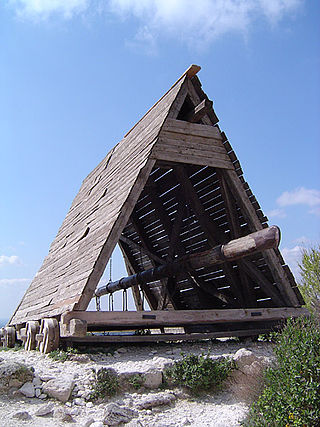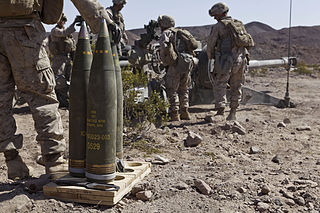Artillery refers to any engine used for the discharge of large projectiles during war.
Contents
Artillery may also refer to:
Artillery refers to any engine used for the discharge of large projectiles during war.
Artillery may also refer to:

Artillery is a class of heavy military ranged weapons that launch munitions far beyond the range and power of infantry firearms. Early artillery development focused on the ability to breach defensive walls and fortifications during sieges, and led to heavy, fairly immobile siege engines. As technology improved, lighter, more mobile field artillery cannons developed for battlefield use. This development continues today; modern self-propelled artillery vehicles are highly mobile weapons of great versatility generally providing the largest share of an army's total firepower.

A firearm is any type of gun designed to be readily carried and used by an individual. The term is legally defined further in different countries.
Range may refer to:

A trebuchet is a type of catapult that uses a long arm to throw a projectile. It was a common powerful siege engine until the advent of gunpowder. The design of a trebuchet allows it to launch projectiles of greater weights and further distances than that of a traditional catapult.
Shot may refer to:
Accelerator may refer to:

In guns, particularly firearms, caliber is the specified nominal internal diameter of the gun barrel bore – regardless of how or where the bore is measured and whether the finished bore matches that specification. It is measured in inches or in millimeters. In the United States it is expressed in hundredths of an inch; in the United Kingdom in thousandths; and elsewhere in millimeters. For example, a "45 caliber" firearm has a barrel diameter of roughly 0.45 inches (11 mm). Barrel diameters can also be expressed using metric dimensions. For example, a "9 mm pistol" has a barrel diameter of about 9 millimeters. Since metric and US customary units do not convert evenly at this scale, metric conversions of caliber measured in decimal inches are typically approximations of the precise specifications in non-metric units, and vice versa.

Ballistics is the field of mechanics concerned with the launching, flight behaviour and impact effects of projectiles, especially ranged weapon munitions such as bullets, unguided bombs, rockets or the like; the science or art of designing and accelerating projectiles so as to achieve a desired performance.

A siege engine is a device that is designed to break or circumvent heavy castle doors, thick city walls and other fortifications in siege warfare. Some are immobile, constructed in place to attack enemy fortifications from a distance, while others have wheels to enable advancing up to the enemy fortification. There are many distinct types, such as siege towers that allow foot soldiers to scale walls and attack the defenders, battering rams that damage walls or gates, and large ranged weapons that attack from a distance by launching projectiles. Some complex siege engines were combinations of these types.

A shell, in a military context, is a projectile whose payload contains an explosive, incendiary, or other chemical filling. Originally it was called a bombshell, but "shell" has come to be unambiguous in a military context. Modern usage sometimes includes large solid kinetic projectiles that is properly termed shot. Solid shot may contain a pyrotechnic compound if a tracer or spotting charge is used.
Roman siege engines were, for the most part, adapted from Hellenistic siege technology. Relatively small efforts were made to develop the technology; however, the Romans brought an unrelentingly aggressive style to siege warfare that brought them repeated success. Up to the first century BC, the Romans utilized siege weapons only as required and relied for the most part on ladders, towers and rams to assault a fortified town. Ballistae were also employed, but held no permanent place within a legion's roster, until later in the republic, and were used sparingly. Julius Caesar took great interest in the integration of advanced siege engines, organizing their use for optimal battlefield efficiency.

Field artillery in the American Civil War refers to the artillery weapons, equipment, and practices used by the Artillery branch to support the infantry and cavalry forces in the field. It does not include siege artillery, use of artillery in fixed fortifications, or coastal or naval artillery. Nor does it include smaller, specialized artillery classified as small arms.
Land warfare or ground warfare is the process of military operations eventuating in combat that takes place predominantly on the battlespace land surface of the planet.

The W33 was an American nuclear artillery shell designed for use in the 8-inch (203 mm) M110 howitzer and M115 howitzer.
The following are terms related to firearms and ammunition topics.

Ammunition is the material fired, scattered, dropped, or detonated from any weapon or weapon system. Ammunition is both expendable weapons and the component parts of other weapons that create the effect on a target.

SP70 self-propelled gun was a scheme set up by several European nations including the UK, Germany and Italy beginning in 1973. The project was shelved in favour of the US M109, which was already in service. The SP70 was 'outgunned' on several occasions by the M109 and further development was cancelled in the 1980s.

James rifle is a generic term to describe any artillery gun rifled to the James pattern for use in the American Civil War, as used in some period documentation. Charles T. James developed a rifled projectile and rifling system. Modern authorities such as Warren Ripley and James Hazlett have suggested that the term "James rifle" only properly applies to 3.8 in (97 mm) bore field artillery pieces rifled to fire James' projectiles. They contend that the term does not apply to smoothbores that were later rifled to take the James projectiles in 3.67 in (93 mm) caliber or other calibers, and that those should instead be referred to as "Rifled 6 pounder", etc.

In artillery, caliber or calibre is the internal diameter of a gun barrel, or - by extension - a relative measure of the barrel length.

The M795 155mm projectile is the US Army and US Marine Corps' standard 155mm High Explosive (HE) projectile for howitzers. It is a bursting round with fragmentation and blast effects.